
Photo courtesy of Shutterstock
Two weeks ago, Chantal Moore, a 22-year-old mother, and member of the Nuu-chah-nulth nation, was killed by a police officer in New Brunswick. She was shot five times because the police claim she had a knife. Moore had no history with the law, weighed 98 pounds, and posed no threat. The police arrived to do a “wellness check” after her boyfriend called them because she had reportedly disclosed to him that she was being harassed by someone and felt afraid.
Indigenous peoples like Chantal Moore make up only 4.8 percent of Canada’s population, yet they make up one-third of the RCMP’s Indigenous victims and 15 percent of police fatalities. In addition, far too many cases of missing, and murdered Indigenous women remain unresolved and many First Nations Reservations still don’t have access to clean drinking water. As a community, they are deprived of basic necessities and human dignity.
The Black Canadian community accounts for 3.4 percent of Canada’s population and 9 percent of police fatalities.
With the murder of George Floyd, the thoughts that flooded many Canadians spiked denial–Denial that our nation has a deep-rooted history of systemic racism, discrimination, and rejection that these issues continue to exist within our borders.
And it is in their unwillingness to accept the reality that we begin to see the true multitude of our problems.
Colonialism in Canada
From the start of recorded Canadian history, the goal of French and British colonizing superpowers was to assimilate the Indigenous peoples they encountered. This goal remained unchanged post-Confederation and in spite of a shift in the 1960s, the consequences of discriminatory legislation remain a reality to this day.
Slavery was abolished in all parts of the British Empire in 1834, 33 years before the Canadian Confederation. However, the segregation of Black Canadians was an accepted practice for many decades afterward. Most segregated schools in Ontario were phased out in 1965. However, the last segregated school in Canada, which was in Nova Scotia, wasn’t closed until 1983.
https://www.instagram.com/p/CBEHJmyHNf-/?igshid=9zafw6ujxpat
Discrimination Against Chinese + Japanese Canadians
Following British Columbia’s entrance into Confederation, construction of a transcontinental railway began. However, difficulty arose in obtaining an adequate workforce in B.C. To fill this gap, thousands of Chinese labourers were imported. Around 15,000 Chinese laborers helped build the CPR—working for little pay in dangerous conditions. It’s estimated that at least 600 of these laborers died and their employment caused much controversy about the potential economic and cultural impact of the influx of Chinese immigrants to Canada.
Consequently, in 1885, the year that the CPR was finished, the Chinese Immigration Act—which established the Chinese “head tax”—was passed, forcing Chinese immigrants to pay a head tax to enter Canada between.
In 1923, the head tax was removed, and the Chinese Immigration Act, also known as the Chinese Exclusion Act, passed and banned all Chinese immigrants until its appeal in 1947. A formal government apology for these atrocities was delivered in 2006.
Violence + Control
Following the Pearl Harbour attack, the federal government faced pressure from the west coast to take action against Japanese Canadians. As a result, on January 14, 1942, Prime Minister King ordered the removal of all males of Japanese ancestry from the coast. This later extended to an Order-in-Council that led to the expulsion of 22,000 Canadian Japanese from their homes, 65 percent of which were Canadian citizens. Most of their property and belongings were sold, and wartime measures remained until April 1, 1989, when they were permitted to return to the west coast. An official apology was issued in September of 1988.
Education Wired to Discriminate
Another atrocity remained in play throughout this period—residential schools. Residential schools were created around 1880 by Christian churches and the Canadian government with intentions of assimilating Indigenous youth into Canadian society. The last residential school closed in 1996, having seen a total of 150,000 students. A formal public apology wasn’t delivered until 2008, and residential schools’ impacts remain evident to this day.
https://www.instagram.com/p/CBBUDV2jSq5/?igshid=1gmblaep4gbba
Following Confederation, Canada’s national police service, The Royal Canadian Mounted Police was created to control Indigenous peoples. Alongside the Indian Act, highly controversial legislation that exists to this day, the RCMP forced Indigenous children from their homes and into residential schools.
By looking at just a fraction of discriminatory Canadian legislation and practices, the systemic racism of our past becomes evident, but we must not forget the racist realities that remain part of our present-day society.
For example, the fact that Black and Indigenous individuals are grossly overrepresented in the corrections system and that they make up an outrageous fraction of police fatalities.
Canada breeds terror against Black and Indigenous people in its’ discriminatory systems and our history mimics the same evils as the U.S. The status quo is killing Canadians and holding our society back from safety and development. It is time to reassess the role of policing and the corrections system in our society and begin investing in our communities because kneeling at a protest is no longer enough.




